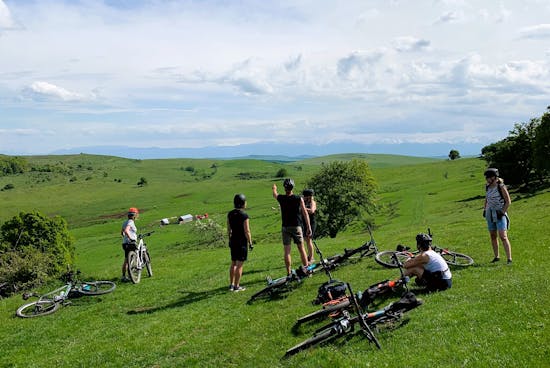We boarded a bus at the Bucharest airport and settled in for a five-hour drive to Richiș, a dot of a town in the foothills of the Carpathian Mountains. I was part of a group of 10 women, all of different nationalities. Our common bond was my childhood best friend, Catherine, who has lived in Europe for almost three decades. It was her idea to bring her friends together in Transylvania, a part of the world most commonly associated with vampires.
Our plans did not involve Vlad the Impaler. Rather, we were embarking on a five-night biking and walking tour with the Slow Cyclist, a British travel company. Founder Oli Broom first visited Transylvania in 2014 and was smitten by its tumbledown quirkiness and authentic field-to-table culture. The Romanian region had an untapped tourism infrastructure in its charmingly restored but mostly empty network of guesthouses. My group visited in May — peak wildflower season.
Our destination was the Saxon Lands, a collection of villages colonized by the Germans in the 12th century. Current residents are mostly Romanians and Gypsies, who scoffed when I asked if they wanted us to refer to them as Romani, which I thought was the more respectful term.
These towns are the land that time forgot. Hay is hauled in horse-driven carts and homes stand close together along dirt roads, like brightly frosted gingerbread houses. There are storks nesting on chimneys and UNESCO-designated fortified churches. Beech forests harbor bears, and gentle high pastures shine gold in the evening sun. Locals congregate for a bump of palinka (fruit brandy) at the bar, and people eat food grown in their gardens, which stretch back behind the houses toward the hills. I spotted more than a few caged rabbits, and they were definitely not pets.
Our first full day got off to a sloppy start when rain forced us to trade a woodland bike path for a highway shoulder where we were sprayed by trucks. The hoped-for al fresco lunch wasn't going to happen.
Any disappointment dissolved when we stepped into a small house in the town of Floresti. As our shoes and coats dried near the wood-burning stove, we toasted with a red liqueur that our guide, Szabi, called a "soft lady schnapps." It tasted of cherries picked from a nearby orchard. I was distracted by the bounty being served: vegetable soup, meatballs, red peppers stuffed with homemade sheep cheese, chicken schnitzel, crepes topped with homemade fruit jam, rhubarb cake covered in meringue. We washed it down with rosé.
We departed, relaxed and fortified, for a slippery walk to Apafi Manor, a pink stucco mansion where we would spend the night. We spotted snails inching through the mud. Our other guide, Marco, explained that the Gypsies harvest them to sell to Italy.
The next morning brought sun and optimism. We'd now be able to relax into the pattern of the journey: breakfast, sightseeing, several hours of biking or hiking, a leisurely lunch, an afternoon bike or walk, dinner, more rosé. We visited timbered churches and private homes. We met farmers and weavers and wine enthusiasts. My favorite meal was spent in the home of Anca and Charlie, a young couple selling their own preserves and craft beer. They served us Varza a la Cluj, a hearty cabbage lasagna.
The vacation glow continued on our third night, when Szabi cautioned that the next day's biking would involve a steep and challenging climb. When we signed up for the trip, we'd each been given a choice of a mountain bike or an e-bike. (The Slow Cyclist now offers e-bikes as standard.) I had decided to forgo the e-bike, reasoning that I cycled regularly in Minneapolis and had competed in a triathlon. Never mind that said event happened over 10 years ago, much less that the foothills in Transylvania are considerably more challenging than anything in Minnesota.
I confided my worries to Bree, the tour's roaming concierge and general problem-solver.
"I can't do that climb," I said.
"No shame in that," she answered. There was no American-style pep talk to encourage me to push myself. "This is supposed to be a vacation."
Bree suggested that she drive me up the paved section of the climb. From there, Szabi would ride alongside me. She told me that the payoff — singletrack and downhill sections with views that stretched forever — would be an experience I wouldn't want to miss.
So that's how I found myself on a dirt path that snaked beneath a canopy of beech and horn beams so thick I couldn't see the sky. Every time I felt like I was about to give up, Szabi urged me to relax and stop forcing myself to go faster.
When we made it to the top, Szabi smiled. Within minutes we were winding through a fairy tale of a forest on an empty singletrack trail. Bree was right — I wouldn't have wanted to miss it.
The final evening was a surprise excursion in horse-drawn carts to a high pasture above the village of Viscri. The rosé came out and we hugged and posed for photos. Then, in what has to be the travel industry's most unique sundowner, we watched a shepherd herd cows down the hill, clambering back into town. Residents were sitting outside, waiting for their cows to, well, come home. Without instruction, the cattle individually peeled away to their barns, like children getting off a school bus.
Some travel writers say that Transylvania is the next Tuscany. The region's rich Old World charm could appeal to a mass audience. But Transylvania is still largely untamed. Dilapidated homes felt as though they could crumble back into the soil. Shepherd dogs leapt and growled and bared their teeth menacingly.
None of these challenges lessened the place's appeal. They made me root for Transylvania and feel a tender attachment long after I left.
Elizabeth Foy Larsen is the author of "111 Places in the Twin Cities That You Must Not Miss."








